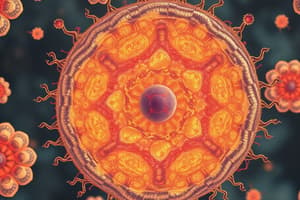Podcast
Questions and Answers
What is the major difference between prokaryotic and eukaryotic cells?
What is the major difference between prokaryotic and eukaryotic cells?
- Eukaryotic cells lack ribosomes.
- Eukaryotic cells have a single strand of DNA.
- Prokaryotic cells contain a membrane-bound nucleus.
- Prokaryotic cells have DNA concentrated in the nucleoid. (correct)
Which of the following statements about ribosomes is correct?
Which of the following statements about ribosomes is correct?
- Ribosomes are responsible for DNA replication.
- Ribosomes are only found in prokaryotic cells.
- Both prokaryotic and eukaryotic cells contain ribosomes. (correct)
- Ribosomes are membrane-bound organelles.
What type of cell division occurs in bacteria?
What type of cell division occurs in bacteria?
- Mitosis
- Asexual reproduction
- Meiosis
- Binary fission (correct)
Which of the following is a characteristic of eukaryotic cells?
Which of the following is a characteristic of eukaryotic cells?
Which structure is not typically associated with prokaryotic cells?
Which structure is not typically associated with prokaryotic cells?
In what type of environment do Archaea typically thrive?
In what type of environment do Archaea typically thrive?
What is true about the genetic diversity of prokaryotes?
What is true about the genetic diversity of prokaryotes?
What is a common feature of both prokaryotic and eukaryotic cells?
What is a common feature of both prokaryotic and eukaryotic cells?
Flashcards are hidden until you start studying
Study Notes
Cell Types Overview
- Two main types of cells: Prokaryotic and Eukaryotic
- Both types are enclosed by a plasma membrane, essential for separating cellular interior from the external environment
- Contain chromosomes, which serve as genetic material
- Ribosomes present in both, responsible for protein synthesis
Prokaryotic Cells
- DNA located in a nucleoid region rather than a nucleus
- Either single or double-stranded DNA; genetic material is simpler
- Lacks a true nucleus and membrane-bound organelles; consists primarily of cytoplasm
- Typically single-celled organisms
- May thrive in environments with or without oxygen
- Earliest known form of life on Earth; includes all bacteria and Archaea
- Tougher structure compared to eukaryotic cells, exhibiting greater genetic diversity
- Surrounded by a cell wall, providing additional rigidity and protection
Prokaryotic Cell Wall
- Gram-Positive Bacterial Cell Wall: Composed of many layers of peptidoglycan, lacking an outer membrane
- Gram-Negative Bacterial Cell Wall: Contains fewer layers of peptidoglycan and is surrounded by an outer membrane
Types of Prokaryotes
- Bacteria: Found in diverse environments
- Archaea: Thrive in extreme conditions such as high temperatures; distinct biochemically and physiologically from bacteria
Binary Fission
- A reproductive method for bacteria involving the inward growth of the plasma membrane
- Results in two daughter cells, each with a complete genome
Eukaryotic Cells
- Characterized by internal membranes that assist in various metabolic processes
- Contain a membrane-bound nucleus housing DNA and specialized organelles
- Typically much larger than prokaryotic cells
- Some possess cell walls, such as plant cells
Domain Eukarya
- Includes diverse groups: Protists, Fungi, Plants, and Animals
Reproduction of Eukaryotic Cells
- Can reproduce via asexual means (e.g., mitosis) or sexual reproduction (e.g., meiosis)
Studying That Suits You
Use AI to generate personalized quizzes and flashcards to suit your learning preferences.




